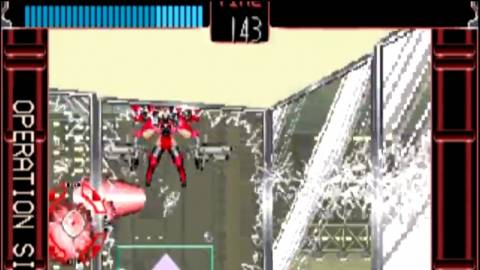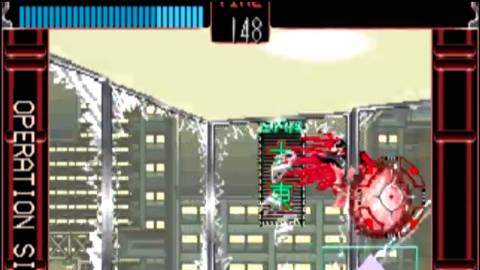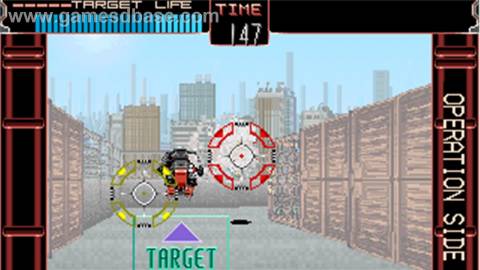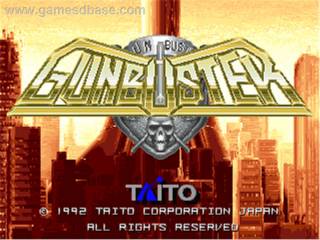Overview
Gun Buster (ガン バスター), also known as Gunbuster (ガンバスター) and released in North America as Operation Gunbuster, is a first-person shooter video game developed by Taito and released for arcades in 1992..[1][2][3][4] In contrast to on-rail light gun shooters (rail shooters) at the time, this was one of the first arcade games to feature free-roaming FPS gameplay, the same year Wolfenstein 3D was released on personal computers.[2][3]
Following Wolfenstein 3D by only a few months, Gun Buster is remarkable for exhibiting features of the FPS genre before they were made popular by games such as Doom and Quake.
Gun Buster's graphics engine (similar to both the Super Scaler and ray casting engines) was also more advanced than what was possible in computer FPS games until the move to 3D polygon graphics.
Gun Buster's control scheme consisted of a joystick for movement and strafing and a light gun for aiming and turning, similar to later Wii Remote first-person shooters for the Wii home console. The player could also carry multiple weapons, each with different recharge rates and movement speeds, and the game's maps included walls, glass and columns that could be used for dodging and shootouts.[2] It also featured multiplayer deathmatch modes for up to four players, between two teams, on a dual-monitor arcade cabinet,[1][2] predating Doom's competitive multiplayer mode.
As the first title to run on the Taito SZ System arcade system board, the game's graphics improved on Taito's previous light gun shooter Space Gun. The graphics were also more detailed and dynamic than other first-person shooters at the time, such as Wolfenstein 3D and Blake Stone;[2][3] in Gun Buster's first level, for example, players can shoot out the windows in a glass elevator.
Information
| Gun Buster ガン バスター Operation Gunbuster | |
|---|---|
| Designer(s) | T. Matsumoto, Ryuji Tominaga |
| Programmer(s) | Shinji Soyano, Hikaru Taniguchi, Akira Ohtsuki, Masashi Tsuzura,Takashi Ishii |
| Artist(s) | Ryuji Tominaga, Tsutomu Sekimoto, Hisakazu Katoh, Takayuki Isobe |
| Composer(s) | Kazuyuki Ohnui, Yasuko Yamada |
| Release date(s) | |
| Mode(s) | Single player, Multiplayer (2-4 players) |
| Cabinet | Upright |
| Arcade system | Taito SZ System[4] |
| CPU | Main: 68EC020 @16 MHz, Sound: 68000 @ 16 MHz |
| Sound | ES5505 @ 15.23805 MHz, ES5510 |
| Display | Dual-monitor (ref), 640×240 resolution (320×240 per screen), 60 Hz refresh rate, 8192 colors on screen, 65,536 color palette(32,768 per screen) |
Gameplay
Gun Buster featured on-foot gameplay and a unique control scheme that was a precursor to most modern FPS control schemes. The player character moves and strafes using an eight-direction joystick, while taking aim (and rotating left and right) using a mounted positional gun (a hybrid between a light gun and analog joystick). The controls work in a similar manner to modern FPS control schemes, including WASD movement & mouse aiming on the PC, the twin-stick controls on consoles, and the analog stick movement & motion control aiming on the Wii.
The game's control scheme consists of both a joystick and a light gun: the joystick moves the player character forwards, backwards and sidewards in a strafing maneuver, while the light gun moves the aiming reticule and turns the character around in clockwise and anti-clockwise directions. The player's arsenal consists of a primary machine gun and several secondary weapons: mines, laser, spark, and fire; each weapon has a different recharge rate and speed of movement. There is also an invincibility shield available that lasts for 15 seconds.[4]
Gun Buster was also unique in allowing two-player co-op for the mission mode, and also featured deathmatch and team deathmatch modes for up to four players, via linked arcade machines, predating the networked deathmatch modes of Doom. Gun Buster also introduced maneuvers such as strafing and circle-strafing several years before they would become popular in the FPS genre.
The mission mode can be played either as a single-player game, or a two-player cooperative game, with the second player able to join in at any time. The mission mode mostly consists of duels with bosses, across thirteen maps (ref). In each map, the players runs through mazes trying to kill boss opponents before they kill the player (ref). The maps include walls, glass and columns that the player can use for dodging and shootouts.[4]
The game's competitive multiplayer mode features a head-to-head deathmatch between two teams (ref). It can be played either between two players, between four players with two players on each team, or between three players with two players on one team and a single player on the other team (ref). The arcade cabinet features a dual-monitor setup, with the second screen used primarily in the deathmatch mode, for the second, third and/or fourth players (ref).
Plot
The game takes place in Agalia City, a fictional science fiction city where cyborg crime has become rampant. In the year 2169, the city offered rewards for cyborg criminals and introduced an organization of hunters. As time passed, humanity began to refer to these hunters as "Gunbusters".
Reception
In 2005, Gamasutra surveyed game developers on their favorite arcade games of all time, with one developer, Ebon Kim of Volt, citing Gun Buster as his "favorite of all time" and writing a brief review, stating he "would play for three hours straight without putting in another quarter" and it was "fun playing against other people." He believed "Gunbuster was a revolutionary First-Person Shooter game" and "before its time" and that if "an upgraded version was out today, many FPS enthusiasts would flock to it and tournaments would be held" or "At least that's what I wish would happen." (ref)
Taito SZ System Arcade Hardware
Main article: Taito SZ System
This game was the debut title for Taito's Taito SZ System arcade hardware, a 32-bit upgrade of their previous Taito Z System arcade hardware.

 Arcade
Arcade








